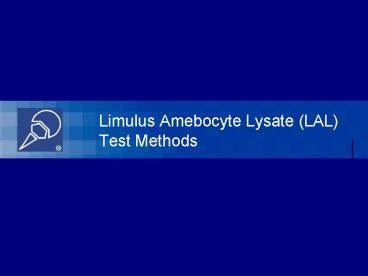Limulus Amebocyte Lysate LAL Test Methods - PowerPoint PPT Presentation
1 / 22
Title:
Limulus Amebocyte Lysate LAL Test Methods
Description:
Modified from Iwanaga et al., 1985. Gelation. Coagulogen. Coagulin. Endotoxin. Factor B ... The labeled gel-clot reagent sensitivity (l) is the least concentration of ... – PowerPoint PPT presentation
Number of Views:4454
Avg rating:3.0/5.0
Title: Limulus Amebocyte Lysate LAL Test Methods
1
Limulus Amebocyte Lysate (LAL) Test Methods
2
LAL Test Methods
- The gel-clot method
- The kinetic turbidimetric method
- The chromogenic methods
- (kinetic and endpoint)
3
Gel-Clot
Turbidimetric
Chromogenic
4
Biochemical Reaction
Endotoxin
Factor C
Activated Factor C
b-Glucan
Factor B
Factor G
Activated Factor(s) B/G
Clotting Enzyme
Activated Clotting Enzyme
Coagulogen
Coagulin
Gelation
Turbidimetric
Modified from Iwanaga et al., 1985
5
The Gel-Clot Method
- Simplest and most widely used
- The USP referee method
- The labeled gel-clot reagent sensitivity (l) is
the least concentration of endotoxin to cause a
solid clot under standard conditions
6
Reading the Gel-Clot Test
7
Turbidimetric Methods
- As coagulin molecules coalesce forming particles,
the reaction mixture becomes turbid - The rate of increase in turbidity is a function
of endotoxin concentration
8
Turbidimetric Methods
light
DETECTOR
9
Kinetic Data - OD vs time
10
Kinetic Turbidimetric Method
- The threshold OD (onset OD) is used as a point of
reference for data collection - The greater the endotoxin concentration, the
shorter the time taken to reach the onset OD
11
Kinetic Turbidimetric Method
- The onset time is the time that it takes (in
seconds) for the reaction to reach the onset OD - Standard curves are constructed by plotting
log10(onset time) on log10(endotoxin
concentration)
12
Standard Curve (Kinetic Test)
13
Kinetic Turbidimetric Method
- Calculate sample endotoxin content by comparing
with standards - Take sample onset time and reference against
standard curve to determine its endotoxin content
14
Interference
- Most samples, at some concentration, interfere
with the LAL reaction - Interference is caused by
- sample interaction with the LAL reagent
- sample interaction with endotoxin
15
Inhibition
- Inhibition is a reduction in sensitivity of the
assay which causes an underestimation of the
concentration of endotoxin - Inhibition controls (PPCs) prevent
misinterpretation of negative results
16
Enhancement
- Enhancement is an increase in the sensitivity of
the assay which causes an overestimation of the
concentration of endotoxin - Positive product controls (PPCs) prevent
misinterpretation of positive results in the
photometric methods
17
False Positives
- Enhancement is not a false positive!
- A false positive test is a positive in the
absence of endotoxin - False positives are rare
- trypsin (all methods)
- activated serine proteases (chromogenic)
- beta-glucans (suspected, all methods)
18
Positive Product Control
- All LAL tests must have a control to demonstrate
that the sample itself does not cause a false
negative result - A known quantity of endotoxin is added to a
portion of the sample under test to provide an
inhibition or positive product control (PPC)
19
Remove Interference
- Dilute with LRW first
- Use a more sensitive LAL reagent or method to
increase the MVD - Reconstitute LAL with Pyrosol (strongly buffered
products outside the pH range, highly
concentrated electrolytes, or for
sample/endotoxin interactions)
20
Maximum Valid Dilution
- The maximum valid dilution (MVD) is the greatest
possible dilution at which the limit can be
detected - This is the dilution used for the pass/fail test
- The MVD increases with increasing test sensitivity
21
Maximum Valid Dilution
- If l is 0.125 EU/mL and the unknown has an
endotoxin limit of 2 EU/mL, calculate the MVD
Limit in EU/mL
2 EU/mL
16
l in EU/mL
0.125 EU/mL
2 EU/mL
Limit in EU/mL
64
l in EU/mL
0.03125 EU/mL
22
Select a Sensitivity
- Sensitivity is lowest point on curve
- Consider the endotoxin limit and MVD
- Perform preliminary tests
- If interference cannot be overcome without
exceeding the MVD of a product, go to a more
sensitive reagent or method































